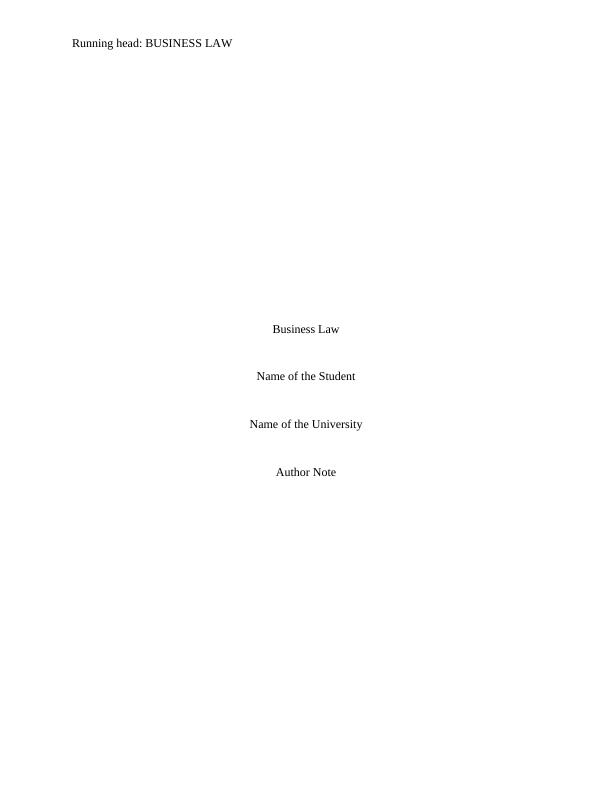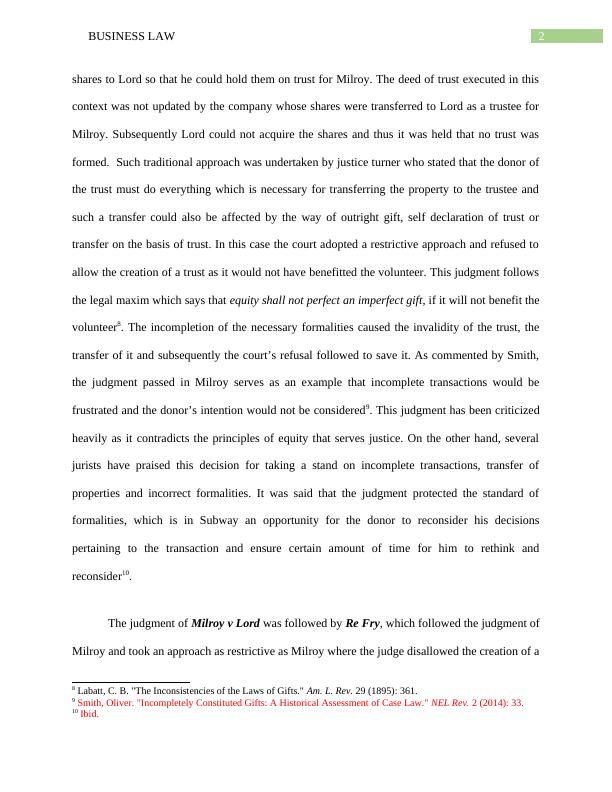Law of Trust in Business Law
Added on 2023-04-22
10 Pages2702 Words480 Views
Running head: BUSINESS LAW
Business Law
Name of the Student
Name of the University
Author Note
Business Law
Name of the Student
Name of the University
Author Note

1BUSINESS LAW
Equity refers to rules that are fair, just and reasonable. The law of trust is a set of rules
that was developed to regulate circumstances where a person trusts another for a particular
purpose. It is mostly created to look after the fund or property that is left for somebody by the
help of a will or trust deed. Equity deals with injustices that are affected by the application of
Common law or an unconscionable behaviour1. Equity depends on various equitable maxims,
which direct the court to exercise their powers as well as discretions accordingly. However, it is
stated that the maxims upon which equity depends are sometimes unreliable. If not meaningless
totally, the maxims have a tendency to mislead and obstruct the process of analysis of the
policies and principles2. The maxims lay down the truth about the principles of equity and trust,
along with exhibiting several exceptions like when the court disallows a volunteer to assist
equity for it did not find convincing reasons to change its decision (when consisting a trust, like
in Milroy v Lord )3. A trust is created when there is a division of legal and equitable interest in
the property4.
The decision held in the case of Re Rose amended the approach of equity in context to
imperfect transactions5. The judgment of this case is related to the creation of a trust property
where it is held that the quotes assist beneficiaries when a trust is created by helping them to
enforce their rights even if being a volunteer6. The principles held in Re Rose can be evaluated,
compared and contrasted only on the basis of its former cases, which held dissenting judgment,
like in Milroy v Lord7. In Milroy v Lord the donor of the trust transferred certain amount of
1 Watt, Gary. Trusts and equity. Oxford University Press, 2018.
2 Webb, Charlie, and Tim Akkouh. Trusts law. Macmillan International Higher Education, 2015.
3 [1862] EWHC J78
4 Clements, Richard, and Ademola Abass. Complete Equity and Trusts: Text, Cases, and Materials. Oxford
University Press, 2018.
5 [1952] EWCA Civ 4
6 Paul v Paul [1882] 20 Ch.D. 742
7 [1862] EWHC J78
Equity refers to rules that are fair, just and reasonable. The law of trust is a set of rules
that was developed to regulate circumstances where a person trusts another for a particular
purpose. It is mostly created to look after the fund or property that is left for somebody by the
help of a will or trust deed. Equity deals with injustices that are affected by the application of
Common law or an unconscionable behaviour1. Equity depends on various equitable maxims,
which direct the court to exercise their powers as well as discretions accordingly. However, it is
stated that the maxims upon which equity depends are sometimes unreliable. If not meaningless
totally, the maxims have a tendency to mislead and obstruct the process of analysis of the
policies and principles2. The maxims lay down the truth about the principles of equity and trust,
along with exhibiting several exceptions like when the court disallows a volunteer to assist
equity for it did not find convincing reasons to change its decision (when consisting a trust, like
in Milroy v Lord )3. A trust is created when there is a division of legal and equitable interest in
the property4.
The decision held in the case of Re Rose amended the approach of equity in context to
imperfect transactions5. The judgment of this case is related to the creation of a trust property
where it is held that the quotes assist beneficiaries when a trust is created by helping them to
enforce their rights even if being a volunteer6. The principles held in Re Rose can be evaluated,
compared and contrasted only on the basis of its former cases, which held dissenting judgment,
like in Milroy v Lord7. In Milroy v Lord the donor of the trust transferred certain amount of
1 Watt, Gary. Trusts and equity. Oxford University Press, 2018.
2 Webb, Charlie, and Tim Akkouh. Trusts law. Macmillan International Higher Education, 2015.
3 [1862] EWHC J78
4 Clements, Richard, and Ademola Abass. Complete Equity and Trusts: Text, Cases, and Materials. Oxford
University Press, 2018.
5 [1952] EWCA Civ 4
6 Paul v Paul [1882] 20 Ch.D. 742
7 [1862] EWHC J78

2BUSINESS LAW
shares to Lord so that he could hold them on trust for Milroy. The deed of trust executed in this
context was not updated by the company whose shares were transferred to Lord as a trustee for
Milroy. Subsequently Lord could not acquire the shares and thus it was held that no trust was
formed. Such traditional approach was undertaken by justice turner who stated that the donor of
the trust must do everything which is necessary for transferring the property to the trustee and
such a transfer could also be affected by the way of outright gift, self declaration of trust or
transfer on the basis of trust. In this case the court adopted a restrictive approach and refused to
allow the creation of a trust as it would not have benefitted the volunteer. This judgment follows
the legal maxim which says that equity shall not perfect an imperfect gift, if it will not benefit the
volunteer8. The incompletion of the necessary formalities caused the invalidity of the trust, the
transfer of it and subsequently the court’s refusal followed to save it. As commented by Smith,
the judgment passed in Milroy serves as an example that incomplete transactions would be
frustrated and the donor’s intention would not be considered9. This judgment has been criticized
heavily as it contradicts the principles of equity that serves justice. On the other hand, several
jurists have praised this decision for taking a stand on incomplete transactions, transfer of
properties and incorrect formalities. It was said that the judgment protected the standard of
formalities, which is in Subway an opportunity for the donor to reconsider his decisions
pertaining to the transaction and ensure certain amount of time for him to rethink and
reconsider10.
The judgment of Milroy v Lord was followed by Re Fry, which followed the judgment of
Milroy and took an approach as restrictive as Milroy where the judge disallowed the creation of a
8 Labatt, C. B. "The Inconsistencies of the Laws of Gifts." Am. L. Rev. 29 (1895): 361.
9 Smith, Oliver. "Incompletely Constituted Gifts: A Historical Assessment of Case Law." NEL Rev. 2 (2014): 33.
10 Ibid.
shares to Lord so that he could hold them on trust for Milroy. The deed of trust executed in this
context was not updated by the company whose shares were transferred to Lord as a trustee for
Milroy. Subsequently Lord could not acquire the shares and thus it was held that no trust was
formed. Such traditional approach was undertaken by justice turner who stated that the donor of
the trust must do everything which is necessary for transferring the property to the trustee and
such a transfer could also be affected by the way of outright gift, self declaration of trust or
transfer on the basis of trust. In this case the court adopted a restrictive approach and refused to
allow the creation of a trust as it would not have benefitted the volunteer. This judgment follows
the legal maxim which says that equity shall not perfect an imperfect gift, if it will not benefit the
volunteer8. The incompletion of the necessary formalities caused the invalidity of the trust, the
transfer of it and subsequently the court’s refusal followed to save it. As commented by Smith,
the judgment passed in Milroy serves as an example that incomplete transactions would be
frustrated and the donor’s intention would not be considered9. This judgment has been criticized
heavily as it contradicts the principles of equity that serves justice. On the other hand, several
jurists have praised this decision for taking a stand on incomplete transactions, transfer of
properties and incorrect formalities. It was said that the judgment protected the standard of
formalities, which is in Subway an opportunity for the donor to reconsider his decisions
pertaining to the transaction and ensure certain amount of time for him to rethink and
reconsider10.
The judgment of Milroy v Lord was followed by Re Fry, which followed the judgment of
Milroy and took an approach as restrictive as Milroy where the judge disallowed the creation of a
8 Labatt, C. B. "The Inconsistencies of the Laws of Gifts." Am. L. Rev. 29 (1895): 361.
9 Smith, Oliver. "Incompletely Constituted Gifts: A Historical Assessment of Case Law." NEL Rev. 2 (2014): 33.
10 Ibid.

End of preview
Want to access all the pages? Upload your documents or become a member.
Related Documents
Equity and Trust: Exceptions to the Principle of 'Equity Will Not Aid a Volunteer'lg...
|11
|3099
|57
The rule of Milroy v Lord [1862] Assignment 2022lg...
|6
|2261
|15
Equity and Trust Assignment PDFlg...
|11
|3197
|67
Milroy v Lord and the Three Certainties in Trustslg...
|5
|3214
|309
Law. ASSIGNMENT. 1. Law. Table of Contents Issue.......lg...
|5
|432
|59
